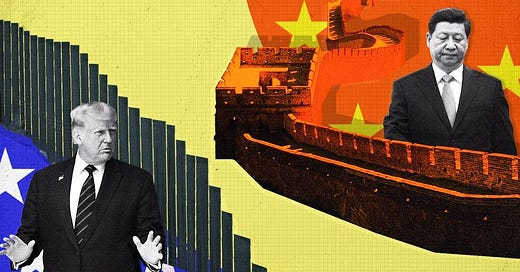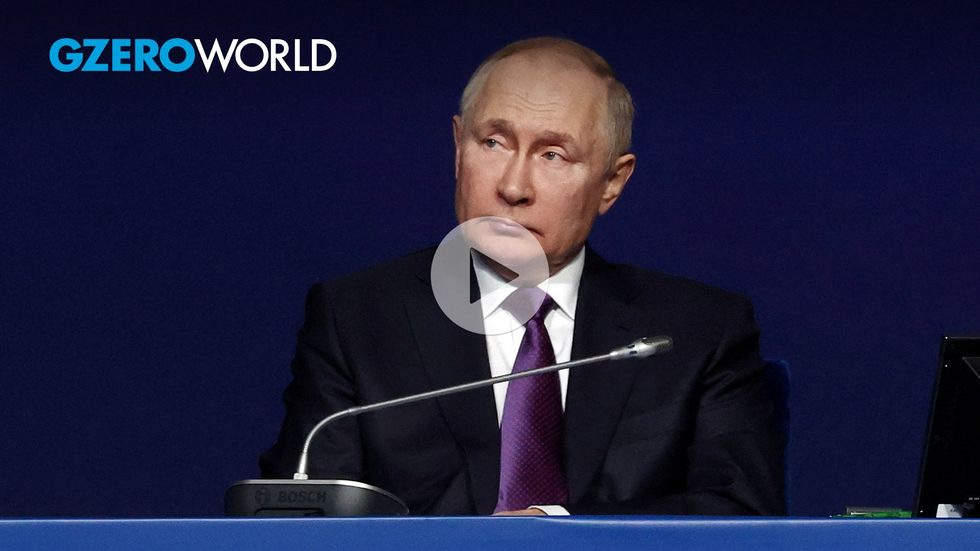Dear reader,
This week, I break down why US-China relations are headed for trouble, discuss Trump’s approach to Ukraine with Finnish President Alexander Stubb, explain why cutting USAID is penny-wise but pound-foolish, and answer your questions on Putin’s latest trolling, Panama's next move, and Turkey’s defense pact with Syria.
Let’s get to it,
- Ian
What Trump’s return means for US-China relations
The first weeks of Donald Trump’s second term have been marked by a sense of optimism about the president’s ability to get a deal with China. And frankly, I understand where it’s coming from.
From Colombia’s overnight capitulation on deportation flights and Panama’s canal cave-in to Canada and Mexico’s (admittedly token) border concessions, Trump has been on a foreign policy roll. Even Denmark – a rock-solid NATO ally – is doing its best impression of the “This is fine” meme despite Trump’s renewed Greenland threats.
This should not surprise any regular readers of this newsletter. I explained exactly why the president was bound to rack up a significant number of early wins over two months ago.
🔔 Subscribe to GZERO Media for free to get timely global analysis and news. For exclusive content and the chance to engage with a community of thinkers, and be a part of the conversation shaping our world 🔔
It’s easy to see how people might see these wins and conclude that Trump can bend anything and anyone to his will – including, perhaps, China. Add in the cordial vibes between the two sides lately – Trump praising Xi Jinping at Davos, delaying the TikTok ban, and imposing lower tariffs against China than US allies; Chinese VP Han Zheng attending the inauguration and talking up “huge common interests” – and you’ve got what looks like signs of a potential breakthrough.
But this optimism fundamentally misunderstands both the limits of Trump’s approach (which I also laid out three weeks ago) and the nature of US-China relations. Let me explain why I think we’re headed for a breakdown in the world’s most important geopolitical relationship.
The art of no deal
First things first: Xi prefers a stable relationship with the US, especially while he deals with serious economic challenges, growing social stability concerns, and an underperforming military. For his part, Trump is not interested in causing a stock market crash at home and would like a “grand bargain” he can sell as a win. Preparations for a summit between the two leaders this year are accordingly ongoing.
But even though Xi and Trump both want a deal, there’s no room for a viable compromise. The gap between what the Trump administration wants and what Beijing is prepared to offer is too wide to bridge.
For China, the goodies on the table are transactional: more agricultural and energy purchases, better treatment for US companies in China, increased Chinese investment in America, a TikTok compromise, and maybe even help brokering a ceasefire in Ukraine. Beijing would also demand concessions in return, especially the rollback of US tech restrictions.
While Trump may be personally enticed by such a deal, it is a nonstarter for the trade and security hawks in his cabinet and the Republican Party. These people don’t see China as a country to accommodate – they see it as a strategic competitor that needs to be contained while America still has the advantage. They want nothing less than structural reforms to China’s economy, complete technological decoupling, and an end to China’s military modernization. That’s obviously not something Xi can negotiate away without essentially giving up China’s core national ambitions, no matter how hard Trump pushes.
Could Trump override his team’s opposition? On lots of issues, absolutely … but on China, I’m not counting on it. And neither are the Chinese. Their goal at this point is to buy time – stringing Trump along as long as they can and playing into his desire to get a deal to keep his hawkish advisers in check, reducing the risk of a near-term breakdown while China’s economy stabilizes.
💬 Got a question you’d like answered? Or thoughts on anything you’ve read so far? Let me know in the comments below—I’d love to hear from you!
Red lines
But this strategy will not last forever. The Trump administration’s actions in a number of policy areas – from trade to tech restrictions to Taiwan policy – are sure to inflame tensions. The cumulative impact of these spoilers will sooner or later cause the bilateral relationship to break down.
Just yesterday, Trump followed through with implementing 10% across-the-board tariffs on Chinese imports. Unlike the tariff threats on Canada and Mexico, this is not a negotiating ploy – it’s the opening salvo in a trade war that will only intensify in the coming months. And unlike the last trade war, this time China is ready to respond despite being economically weaker.
Beijing hit back with counter-tariffs on American energy and manufacturing, slapped export controls on critical minerals, and launched an antitrust investigation into Google. All things considered, this was a relatively measured response, calibrated to show strength while maintaining space for negotiations and keeping powder dry for bigger fights ahead. Come April 1, when the Trump administration’s trade policy investigations wrap up, we’re likely to see major new tariffs and tech restrictions – and more aggressive Chinese retaliation.
But the real breaking point may come not from tariffs – or from escalating tech restrictions or a cross-strait crisis – but from US actions targeting the legitimacy of the Chinese Communist Party. Events in 2020, when relations broke down during the COVID-19 pandemic, convinced China’s leaders that Washington is irredeemably bent on containing China’s rise and – ultimately – unseating the CCP regime. Trump’s appointment of vocal China hawks like Secretary of State Marco Rubio and National Security Adviser Mike Waltz has reinforced that conviction.
CIA Director John Ratcliffe’s first move in office was to flip the agency’s position on COVID-19’s origins to support the lab leak theory, something Beijing is particularly sensitive about and has identified as a bright red line. Sen. Tom Cotton praised the move as key to making China “pay for unleashing a plague.” A few days later, a US appeals court allowed a lawsuit lodged by the state of Missouri against the CCP – not China the country but the Party itself – for $25 billion in pandemic-related damages to proceed. Long overdue intelligence reports on CCP leaders’ assets could be another flashpoint.
Should any of these efforts lead to the seizure of CCP-linked assets in America, China will hit back and hit back hard – potentially seizing American assets in China and causing a breakdown in the relationship before a first meeting between Trump and Xi can even take place.
No guardrails
The most geopolitically important relationship in the world is fundamentally adversarial and devoid of trust. The only reason why it was comparatively stable in 2024 was that the Biden administration expended serious effort to develop and maintain 25 high-level bilateral channels across the cabinet.
But the Trump team has no interest in putting in that kind of painstaking diplomatic work for a relationship they view as fundamentally adversarial. Without those guardrails, there will be few management and communication mechanisms to prevent even minor provocations from spiraling into a major crisis.
Many people want to believe that Trump will somehow overcome this reality and bully Beijing into a deal. The problem is that his strongman tactics only work against much weaker countries. When he threatens Colombia and Panama with tariffs, they have no choice but to capitulate – their economies would collapse otherwise. But punching down is easy. China is an entirely different ball game: It has the size and leverage to punch back against the US in ways that other countries cannot. And punch back it will.
Though neither Trump nor Xi wants a costly confrontation in 2025, the US and China are headed for trouble. Both countries will pay a price as their economies decouple, and the breakdown will ripple worldwide, increasing costs for consumers and businesses everywhere. Most countries have zero interest in picking sides in a new cold war. But key US allies and trading partners – Japan, South Korea, Mexico, the EU – are increasingly going to have a hard time navigating that, especially on security-related issues.
The breakdown in relations will deepen bilateral suspicion and mistrust, increasing the risk of unintended escalation. It’s going to get worse before it gets better.
📢 Agree, disagree, or somewhere in between? Share this post and let the debate travel.
Trump’s Ukraine strategy
With Donald Trump back in the White House, Europeans leaders are largely bracing for disruption and chaos. But Finnish President Alexander Stubb is cautiously optimistic about the new administration’s approach to one policy area: the Russia-Ukraine war. In a wide-ranging interview for GZERO World on the sidelines of Davos, he told me Trump “wants to win this peace.”
The problem is that the Ukrainians don’t have enough leverage yet to enter negotiations from a position of strength. Getting them from here to there requires convincing Putin that “his economy is weak and he’s not advancing on the military front.” According to Stubb, Trump is very much on board with this strategy.
But what does that entail in practice? And what would the minimum acceptable deal look like?
Watch the clip here and catch my full interview with President Stubb in the latest episode of “GZERO World with Ian Bremmer,” also airing on your local public television station.
A message from our sponsor Walmart
"Walmart has helped us lead the trend of non-alcoholic beer"
Walmart is fueling American jobs and strengthening communities by investing in local businesses. Athletic Brewing landed a deal with Walmart in 2021. Since then, co-founders Bill Shufelt and John Walker have hired more than 200 employees and built a150,000-square-foot brewery in Milford, CT. Athletic Brewing is one of many US-based suppliers working with Walmart. By 2030, the retailer is estimated to support the creation of over 750,000 US jobs by investing an additional $350 billion in products made, grown, or assembled in America. Learn more about Walmart’s commitment to US manufacturing.
Why cutting USAID will hurt American interests
The Trump administration is in the process of shutting down the US Agency for International Development. Nearly all its Washington staff have been put on leave, its missions abroad are being shuttered, and all personnel stationed around the world are being evacuated. Set up in 1961 by President John F. Kennedy, USAID has long been a crucial tool in America’s global power projection arsenal. Why does its dismantling matter?
Watch my latest Quick Take to find out.
You ask, I answer
This week, you asked:
What does Putin mean when he says Europe “will stand at the feet of the master”?
What’s next for Panama after deciding to exit China’s Belt and Road Initiative?
How would a potential Turkey defense pact with Syria reshape power dynamics in the Middle East?
Check out my answers to your questions in the latest World in 60 Seconds.
Moose’s treat of the week
“Bright vs. blurry lines: how to think about executive power grabs” by Julia Azari, an excellent framework to keep in mind as you read the news and try to sort the hay from the chaff.












I wrote this piece breaking down how the Democratic Party’s failure to lead has left a dangerous vacuum just as Trump is consolidating power—and why Obama is the only figure with the influence, presence, and voice to challenge him.
Democrats don’t just need a better message—they need a movement. And the only person who can build it is Obama.
Would love to hear your thoughts when you have a minute
https://open.substack.com/pub/jasonegenberg/p/mr-president-the-country-needs-you?r=3nm35j&utm_medium=ios
….um …. anatomically impossible :) :) I know….you are a dump as a rock lol